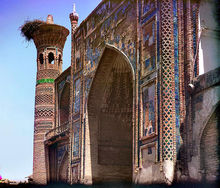
The word "madrasah" also exists in many Arabic-influenced languages such as Urdu, Hindi, Farsi, Turkish, Kurdish, Indonesian, Malaysian and Bosnian. In the Arabic language, the word مدرسة implies no sense other than that which the word school represents in the English language, such as private, public or parochial school, as well as for any primary or secondary school whether Muslim, non-Muslim or secular. Unlike the understanding of the word school in British English, the word madrasah refers in American English to a university-level or post-graduate Islamic school. The correct Arabic word for a university, however, is Jami'ah. The Hebrew cognate "midrasha" also connotes the meaning of a place of learning. There are some madrasah-like institutions also in North America and in Europe. A Madrasah complex in The Gambia A typical madrasah usually offers two courses of study: a "hifz" course; that is memorisation of the Qur'an (the person who commits the entire Qur'an to memory is called a hafiz); and an 'alim course leading the candidate to become an accepted scholar in the community. A regular curriculum includes courses in Arabic, Tafsir (Qur'anic interpretation), shari'ah (Islamic law), Hadith (recorded sayings and deeds of Prophet Muhammad), Mantiq (logic), and Muslim History. Depending on the educational demands, some madrasahs also offer additional advanced courses in Arabic literature, English, and other foreign languages as well as science and world history.
People of all ages attend, and many often move on to becoming imams. The certificate of an 'alim' for example, requires approximately twelve years of study. A good number of the huffaz (plural of hafiz) are the product of the madrasahs. The madrasahs also resemble colleges, where people take evening classes and reside in dormitories. An important function of the madrasahs is to admit orphans and poor children in order to provide them with education and training. Madrassahs may enroll female students; however, they generally study separately from the men. There are examples of all-female madrassahs.
In South Africa, madrasahs play an important role in giving after-school religious instruction to Muslim children who attend government, or private non-religious schools. However, increasing numbers of more affluent Muslim children attend full-fledged private Islamic Schools which combine secular and religious education. Among Muslims of Indian origin, madrasahs also used to provide instruction in Urdu, although this is far less common today than it used to be.
History
Madrasahs did not exist in the early period of Islam. Their formation can probably be traced to the early Islamic custom of meeting in mosques to discuss religious issues. At this early stage, people seeking religious knowledge tended to gather around certain more knowledgable Muslims; these informal teachers later became known as the shaykhs; and these shaykhs began to hold regular religious education sessions called 'majalis'.
Established in 859, Jami'at al-Qarawiyyin (located in Al-Qarawiyyin Mosque) in the city of Fas (Fez), it is considered the oldest madrasah in the Muslim world.
During the late Abbasid period, the Seljuk vizier Nizam al-Mulk created the first major official academic institution known in history as the Nizamiyyah, based on the informal majalis (sessions of the shaykhs). Al-Mulk, who would later be murdered by the Assassins (Hashshashin), created a system of state madrasahs (in his time they were called, the Nizamiyyahs, named after him) in various Abbasid cities at the end of the 11th century.
During the rule of the Fatimid and Mamluk dynasties and their successor states in the medieval Middle East, many of the ruling elite founded madrasas through a religious endowment known as the waq'f. Not only was the madrasa a potent symbol of status but it was an effective means of transmitting wealth and status to their descendents. Especially during the Mamluk period, when only former slaves could assume power, the sons of the ruling Mamluk elite were unable to inherit. Guaranteed positions within the new madrasas thus allowed them to maintain status. Madrasas built in this period include the Mosque-Madrassa of Sultan Hassan in Cairo.



Hiç yorum yok:
Yorum Gönder